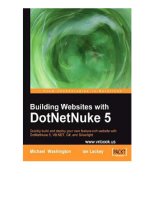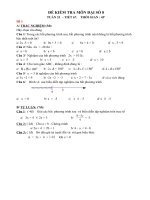4 5 3 two women astronauts (social studies)
Bạn đang xem bản rút gọn của tài liệu. Xem và tải ngay bản đầy đủ của tài liệu tại đây (3.01 MB, 12 trang )
Suggested levels for Guided Reading, DRA,™
Lexile,® and Reading Recovery™ are provided
in the Pearson Scott Foresman Leveling Guide.
Biography
Two Women
Astronauts
Genre
Expository
nonfiction
Comprehension
Skills and Strategy
• Sequence
• Generalize
• Text Structure
Text Features
•
•
•
•
Table of Contents
Captions
Time Line
Glossary
Scott Foresman Reading Street 4.5.3
ISBN 0-328-13480-5
ì<(sk$m)=bdeiaj< +^-Ä-U-Ä-U
by Ian Gale
Reader Response
Two Women
Astronauts
1. Make two time lines like the one below. Show
the events in the lives of both Sally Ride and Mae
Jemison on their journeys to becoming astronauts.
Event
Year
2. The author told about the lives of these two
astronauts in chronological order, that is, in the
order in which the events happened. How did this
structure help you to better understand what you
read? How else might the author have ordered
the book?
3. The word biofeedback contains the Greek root
bio. Look up bio in a dictionary and explain
how its meaning could help you figure out the
meaning of the word biofeedback. List other
words you know that contain the root bio.
4. Think about the two astronauts’ lives. What do
you think was the most difficult challenge each
had to face? Explain your answer.
by Ian Gale
Editorial Offices: Glenview, Illinois • Parsippany, New Jersey • New York, New York
Sales Offices: Needham, Massachusetts • Duluth, Georgia • Glenview, Illinois
Coppell, Texas • Ontario, California • Mesa, Arizona
CONTENTS
CHAPTER 1
4
Two Special Women
CHAPTER 2
6
Meet Dr. Sally Ride
CHAPTER 3
Every effort has been made to secure permission and provide appropriate credit for
photographic material. The publisher deeply regrets any omission and pledges to
correct errors called to its attention in subsequent editions.
Unless otherwise acknowledged, all photographs are the property of Scott Foresman,
a division of Pearson Education.
Photo locators denoted as follows: Top (T), Center (C), Bottom (B), Left (L), Right (R),
Background (Bkgd)
Opener (R)©Bettmann/Corbis, Opener (L)©Time Life Pictures/NASA/Getty Images;
5 ©Bettmann/Corbis; 9 KSC/NASA 11 ©Time Life Pictures/NASA/Getty Images;
12 ©NASA/Roger Ressmeyer/Corbis; 13 ©NASA/Roger Ressmeyer/Corbis; 15 ©Marc
Asnin/Corbis; 18 ©Richard T. Nowitz/Corbis
10
Meet Dr. Mae Jemison
CHAPTER 4
16
Women in Space
Now Try This
18
Glossary
20
ISBN: 0-328-13480-5
Copyright © Pearson Education, Inc.
All Rights Reserved. Printed in the United States of America. This publication is
protected by copyright, and permission should be obtained from the publisher
prior to any prohibited reproduction, storage in a retrieval system, or transmission
in any form by any means, electronic, mechanical, photocopying, recording, or
likewise. For information regarding permission(s), write to: Permissions Department,
Scott Foresman, 1900 East Lake Avenue, Glenview, Illinois 60025.
2 3 4 5 6 7 8 9 10 V0G1 14 13 12 11 10 09 08 07 06 05
3
Chapter 1
Two Special Women
What do scientists do? They try to figure out
how things work and why things happen. A
scientist might attempt to understand patterns
in the weather or help find cures for illnesses.
Scientists have skills that can lead them to
interesting careers.
For two American women, careers as scientists
led them all the way to outer space! Dr. Sally
Ride, from California, and Dr. Mae Jemison, from
Alabama, made history when they ventured into
outer space.
In 1983 Sally Ride became the first American
woman in space, while Mae Jemison made
history in 1992 when she became the first African
American woman to travel into space.
Sally Ride and Mae Jemison are two famous
former astronauts who worked for the National
Aeronautics and Space Administration (NASA).
4
5
Chapter 2
Meet Dr. Sally Ride
When Sally Ride was a youngster growing up
in California, she wasn’t interested in traveling
to space, after all, the space program hadn’t yet
started. Like many other children her age, Sally
was interested in playing sports and having fun
with her friends.
In addition to participating in and enjoying
tennis and other sports, Sally developed an avid
interest in science. In fact, she was so interested
in science that she chose it as a major subject in
college.
Sally studied and earned several degrees in
physics from Stanford University in California. It
was at Stanford that Sally would take her first
step toward becoming an astronaut.
It was an advertisement in the university’s
newspaper that caught Sally’s attention. The
ad explained that NASA was hiring astronaut
candidates for its new space shuttle program.
NASA particularly needed people who knew
about astronomy and other sciences.
6
Sally was intrigued by the thought of
becoming an astronaut and training with NASA,
so she decided to apply. Competition for the job
was extremely tough. More than one thousand
other women, along with many thousands of
men, sent applications to NASA. From among
all of the applicants, NASA reduced the list of
possible candidates to just thirty-five people—
and Sally was one of them!
She was required to take many tests, and she
went through an arduous interview process at
the Johnson Space Center in Houston, Texas.
But Sally made the team! Soon she would be an
astronaut—a mission specialist to be exact. That’s
the position she would be training for.
It would be a year, however, before Sally
would be ready to take her first flight into outer
space aboard the space shuttle Challenger.
During training Sally became the expert on
the Remote Manipulator System. This system is
a giant robotic arm that is used to move cargo
in the shuttle’s payload bay and to pick up and
release satellites that the shuttle is placing in
orbit.
7
After one year of rigorous training, Sally was
eligible for assignment as a mission specialist on
a space shuttle flight crew. She wasn’t assigned
to a shuttle mission immediately, however. First,
as part of additional training, she was a member
of the support crew of other shuttle flights and
worked in NASA’s mission control as a capsule
communicator, or CAPCOM. In this role, Sally
was responsible for communicating information
and data from scientists and other experts to the
shuttle crew in space.
Finally, Sally’s chance to be a shuttle
crewmember arrived. Sally Ride was about to
become the first American female astronaut!
It was the summer of 1983, and the space
shuttle Challenger was cleared for lift-off.
Commander Bob Crippen led Sally and the
other Challenger astronauts into the special
room where they would put on their protective
spacesuits and prepare to board the space
shuttle.
After the crew was strapped in place and the
shuttle was ready to go, the engines roared.
Sally Ride was on her way into outer space. Her
journey into space and back lasted six days, two
hours, and twenty-four minutes.
8
Challenger lift-off, 1983
9
Chapter 3
Meet Dr. Mae Jemison
Dr. Mae Jemison,
Astronaut
Mae Jemison was born in Alabama in 1956.
When Mae was three years old, her family moved
to Chicago, Illinois. There, Mae spent a great deal
of time at the public library reading books and
learning about science. She also loved languages
and, over the years, learned Russian, Japanese,
and Swahili—an African language. From an early
age, however, Mae was determined to become a
scientist.
At the age of sixteen, Mae entered Stanford
University, where she earned degrees in chemical
engineering and African American studies. Mae
then went on to become a medical doctor. She
studied at and received her medical degree from
Cornell University in New York.
Mae was very interested in helping people
in disadvantaged countries, so she joined the
Peace Corps, an organization that works to help
individuals in developing countries who want to
build a better life for themselves, their children,
and their communities. As a member of the Peace
Corps, Mae traveled to the African nations of
Sierra Leone and Liberia. She worked as a doctor
providing medical care to the people there.
When Mae returned to the United States, she
practiced medicine in California. However, she
missed working in other scientific fields, so she
applied for a mission specialist position at NASA.
10
11
In 1987 Mae Jemison was accepted into NASA’s
space training program. For the next five years,
Mae trained and worked on many projects at
NASA. It was very hard work, but Mae was excited
at the prospect of making history. She would be
the first African American woman in space.
In 1992 Mae took her first journey into space
aboard the space shuttle Endeavour. Mae’s job
on that mission was to help conduct experiments
in space. Mae’s knowledge of science and
medicine also helped her to experiment on
herself! For example, biofeedback is information
obtained from monitoring your body and then
using this information to control brain waves
and body processes, such as heart rate and blood
pressure. Mae used biofeedback to help her
overcome space motion sickness.
Mae also experimented with frog eggs on her
shuttle mission in space. Scientists know how
long it takes a frog to develop from an egg into
an adult frog here on Earth. They didn’t know
whether frog eggs would develop at the same
rate in outer space as they do on Earth.
Mae conducted her experiments on frog eggs
for the eight days of the shuttle mission and
discovered that frog eggs do, indeed, develop at
the same rate.
In total, Mae helped conduct more than forty
different experiments during her space journey.
Jan Davis and Mae Jemison set up an experiment
on the space shuttle.
Dr. Mae Jemison, September, 1992
12
13
After her Endeavour mission, Mae left NASA
and became a college professor. She also became
director of the Jemison Institute at Dartmouth
College in New Hampshire, where scientists
and experts from all over the world gather to
work on technology that will help people in
developing countries.
Mae Jemison has worked as a scientist, doctor,
and an astronaut. She has even written a book
about her life. Find Where the Wind Goes:
Moments from My Life tells the story of Mae’s
life and how she fulfilled her dreams.
Whatever career Mae Jemison chooses for
herself in the future, she will always look back
proudly at her efforts and accomplishments in
becoming the first African American woman in
space.
14
15
WOMEN IN SPACE
Chapter 4
Women in Space
The two women you’ve just read about have
both made history. Dr. Sally Ride was the first
American woman in space, and Dr. Mae Jemison
was the first African American woman in space.
Other women have also traveled into outer
space and made history. A Russian woman,
Valentina Tereshkova, was the very first woman
in space, while Kathryn Sullivan from New Jersey
became the first American woman to walk in
space. Interestingly, Sally Ride was a member of
the same shuttle flight crew as Kathryn Sullivan
when Sullivan took her spacewalk. It was Sally
Ride’s second shuttle flight.
In 1993 Ellen Ochoa became the first Hispanic
American woman to travel to outer space, and
a year later Chiaki Mukai was the first Japanese
woman in space.
American Eileen Collins became the first
woman to take command of a spacecraft—she
was Shuttle Commander of Discovery in 1999.
16
1959
Geraldine Cobb is the first woman to
pass the tests for the United States’
Mercury astronaut training program.
1963
Valentina Tereshkova from Russia
becomes the first woman in space.
1983
1984
Sally Ride becomes the first American
woman in space.
Kathryn Sullivan becomes first
American woman to walk in space.
1992
Mae Jemison becomes the first
African American woman in space.
1999
Eileen Collins becomes the first
woman space shuttle commander.
17
Now Try This
Are You Ready for Take Off?
Imagine you are an astronaut! What would it
be like to travel into space on a space shuttle or
other spacecraft? Write down your thoughts and
feelings. Keep a journal.
to Do It!
w
o
H
s
’
e
r
He
Read the following events. Write a journal
page for each one, describing what you think it
would be like to experience each event.
• You’re blasting off from Earth. How does it
feel? What do you see?
• You have eaten and slept in space. What
predictions can you make about average
people traveling and doing everyday things in
space?
• You have been in space for two days. How has
your body reacted? How have you adjusted?
• You are orbiting Earth for the second time.
What have you seen?
• How has your training prepared you for this
work and this journey?
If you wish, share your journal with your
classmates.
18
19
Glossary
astronauts n.
persons trained to
pilot, navigate, or
otherwise participate
as crew members of a
spacecraft.
astronomy n. the study
of matter in outer space.
biofeedback n.
information about
one’s body and body
processes obtained from
monitoring devices,
and then the use of this
information to control
brain waves and body
processes.
Reader Response
data n. factual
information
ventured v. dared to
proceed.
satellites n. objects that
orbit a planet; often
refers to human-made
objects that are placed
in Earth’s orbit.
1. Make two time lines like the one below. Show
the events in the lives of both Sally Ride and Mae
Jemison on their journeys to becoming astronauts.
Event
Year
2. The author told about the lives of these two
astronauts in chronological order, that is, in the
order in which the events happened. How did this
structure help you to better understand what you
read? How else might the author have ordered
the book?
3. The word biofeedback contains the Greek root
bio. Look up bio in a dictionary and explain
how its meaning could help you figure out the
meaning of the word biofeedback. List other
words you know that contain the root bio.
4. Think about the two astronauts’ lives. What do
you think was the most difficult challenge each
had to face? Explain your answer.
20









